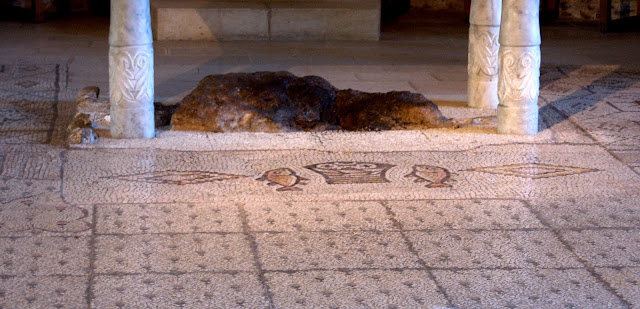
The Exterior of the Church of the Multiplication of the Loaves and the Fishes
Windows above the entrance to the church (looking toward the back)
From 24 AD - 350 AD the Christians from Capernaum venerated a large rock on which they believe (and tradition teaches) that Jesus laid the loaves and the fishes before he fed the 5000 (Mark 6:30-44).
The Interior of the Church
Later, in 350 AD they used that rock as an altar and it was the very center of the very first church built on this site by a Jewish nobleman, Josipos, from Tiberias. The church was built in close alignment with the ancient Via Maris, an important trade route.
The Limestone Rock under the Altar - Where Jesus Placed the Loaves and Fishes
Notice the original mosaics featuring a basket of loaves and fishes
Notice the original mosaics featuring a basket of loaves and fishes
By 480 AD a Byzantine church with an unusual transept was erected with a mosaic floor of great artistic value. You can see that the building and its mosaics were influenced by Egyptian art. The historic rock was moved and placed beneath the altar. (see above)
In 614 AD during the Persian invasion, the Heptapegon (ancient name for the city of Tabgha) church was destroyed and its ruins remained hidden for 1300 years until 1932 when a Catholic priest/archaeologist excavated this site. He uncovered the beautiful mosaics and found them to be largely intact.
In 1980-82 the ancient Byzantine basilica was reconstructed on its original foundations and remains today a church operated by the Benedictine order.
John Luke and Harrison are enjoying learning about the history of this church and its symbols.

They had cute little baskets set on the floor of the church to represent the baskets of fish and loaves left over. Note: Not an original basket. :)
John Luke and Harrison are enjoying learning about the history of this church and its symbols.
Evan taking in the sites of the courtyard of the Church of the Multiplication.
There are springs, and little streams with koi swimming, water lilies blooming, and the sound of rushing water to enjoy in the garden of the courtyard.

Olive Tree in the Center of the Courtyard of the Church of the Multiplication







No comments:
Post a Comment